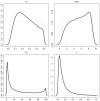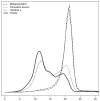Approximate Bayesian estimation of extinction rate in the Finnish Daphnia magna metapopulation
- PMID: 23551417
- PMCID: PMC4615701
- DOI: 10.1111/mec.12283
Approximate Bayesian estimation of extinction rate in the Finnish Daphnia magna metapopulation
Abstract
Approximate Bayesian computation (ABC) is useful for parameterizing complex models in population genetics. In this study, ABC was applied to simultaneously estimate parameter values for a model of metapopulation coalescence and test two alternatives to a strict metapopulation model in the well-studied network of Daphnia magna populations in Finland. The models shared four free parameters: the subpopulation genetic diversity (θS), the rate of gene flow among patches (4Nm), the founding population size (N0) and the metapopulation extinction rate (e) but differed in the distribution of extinction rates across habitat patches in the system. The three models had either a constant extinction rate in all populations (strict metapopulation), one population that was protected from local extinction (i.e. a persistent source), or habitat-specific extinction rates drawn from a distribution with specified mean and variance. Our model selection analysis favoured the model including a persistent source population over the two alternative models. Of the closest 750,000 data sets in Euclidean space, 78% were simulated under the persistent source model (estimated posterior probability = 0.769). This fraction increased to more than 85% when only the closest 150,000 data sets were considered (estimated posterior probability = 0.774). Approximate Bayesian computation was then used to estimate parameter values that might produce the observed set of summary statistics. Our analysis provided posterior distributions for e that included the point estimate obtained from previous data from the Finnish D. magna metapopulation. Our results support the use of ABC and population genetic data for testing the strict metapopulation model and parameterizing complex models of demography.
© 2013 Blackwell Publishing Ltd.
Figures



Similar articles
-
Genetic estimates of population age in the water flea, Daphnia magna.J Hered. 2012 Nov-Dec;103(6):887-97. doi: 10.1093/jhered/ess063. Epub 2012 Nov 4. J Hered. 2012. PMID: 23129752 Free PMC article.
-
Unsuitable habitat patches lead to severe underestimation of dynamics and gene flow in a zooplankton metapopulation.J Anim Ecol. 2013 Jul;82(4):759-69. doi: 10.1111/1365-2656.12044. Epub 2013 Mar 15. J Anim Ecol. 2013. PMID: 23496795
-
Populations in small, ephemeral habitat patches may drive dynamics in a Daphnia magna metapopulation.Ecology. 2010 Oct;91(10):2975-82. doi: 10.1890/09-2016.1. Ecology. 2010. PMID: 21058557
-
Effects of metapopulation processes on measures of genetic diversity.Philos Trans R Soc Lond B Biol Sci. 2000 Dec 29;355(1404):1851-64. doi: 10.1098/rstb.2000.0740. Philos Trans R Soc Lond B Biol Sci. 2000. PMID: 11205346 Free PMC article. Review.
-
On the use of kernel approximate Bayesian computation to infer population history.Genes Genet Syst. 2015;90(3):153-62. doi: 10.1266/ggs.90.153. Genes Genet Syst. 2015. PMID: 26510570 Review.
Cited by
-
Coalescent models characterize sources and demographic history of recent round goby colonization of Great Lakes and inland waters.Evol Appl. 2019 Mar 23;12(5):1034-1049. doi: 10.1111/eva.12779. eCollection 2019 Jun. Evol Appl. 2019. PMID: 31080513 Free PMC article.
-
Combining incidence and demographic modelling approaches to evaluate metapopulation parameters for an endangered riparian plant.AoB Plants. 2016 Jul 11;8:plw044. doi: 10.1093/aobpla/plw044. Print 2016. AoB Plants. 2016. PMID: 27339047 Free PMC article.
-
ABC inference of multi-population divergence with admixture from unphased population genomic data.Mol Ecol. 2014 Sep;23(18):4458-71. doi: 10.1111/mec.12881. Epub 2014 Sep 6. Mol Ecol. 2014. PMID: 25113024 Free PMC article.
-
Demographic divergence history of pied flycatcher and collared flycatcher inferred from whole-genome re-sequencing data.PLoS Genet. 2013 Nov;9(11):e1003942. doi: 10.1371/journal.pgen.1003942. Epub 2013 Nov 7. PLoS Genet. 2013. PMID: 24244198 Free PMC article.
-
Determinants of genetic structure in a nonequilibrium metapopulation of the plant Silene latifolia.PLoS One. 2014 Sep 8;9(9):e104575. doi: 10.1371/journal.pone.0104575. eCollection 2014. PLoS One. 2014. PMID: 25198341 Free PMC article.
References
-
- Altermatt F, Ebert D. Genetic diversity of Daphnia magna populations enhances resistance to parasites. Ecology Letters. 2008;11:918–928. - PubMed
-
- Barson NJ, Cable J, Van Oosterhout C. Population genetic analysis of microsatellite variation of guppies (Poecilia reticulata) in Trinidad and Tobago: evidence for a dynamic source-sink metapopulation structure, founder events and population bottlenecks. Journal of Evolutionary Biology. 2009;22:485–497. - PubMed
-
- Beaumont MA. Approximate Bayesian computation in evolution and ecology. Annual Review of Ecology, Evolution, and Systematics. 2010;41:379–406.
-
- Beerli P. Effect of unsampled populations on the estimation of population sizes and migration rates between sampled populations. Molecular Ecology. 2004;13:827–836. - PubMed
Publication types
MeSH terms
Grants and funding
LinkOut - more resources
Full Text Sources
Other Literature Sources

